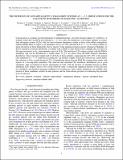THE INCIDENCE OF LOW-METALLICITY LYMAN-LIMIT SYSTEMS AT z ~ 3.5: IMPLICATIONS FOR THE COLD-FLOW HYPOTHESIS OF BARYONIC ACCRETION
Author(s)
Simcoe, Robert A.; O'Meara, John M.; Cooper, Thomas Jared; Cooksey, Kathy; Torrey, Paul A.
DownloadCooper-2015-The incidence of low.pdf (3.253Mb)
PUBLISHER_POLICY
Publisher Policy
Article is made available in accordance with the publisher's policy and may be subject to US copyright law. Please refer to the publisher's site for terms of use.
Terms of use
Metadata
Show full item recordAbstract
Cold accretion is a primary growth mechanism of simulated galaxies, yet observational evidence of "cold flows" at redshifts where they should be most efficient (z = 2–4) is scarce. In simulations, cold streams manifest as Lyman-limit absorption systems (LLSs) with low heavy-element abundances similar to those of the diffuse intergalactic medium (IGM). Here we report on an abundance survey of 17 H i-selected LLSs at z = 3.2–4.4 which exhibits no metal absorption in Sloan Digital Sky Survey spectra. Using medium-resolution spectra obtained at Magellan, we derive ionization-corrected metallicities (or limits) with a Markov-chain Monte Carlo sampling that accounts for the large uncertainty in N[subscript H i] measurements typical of LLSs. The metal-poor LLS sample overlaps with the IGM in metallicity and can be described by a model where 71[+13 over -11]% are drawn from the IGM chemical abundance distribution. These represent roughly half of all LLSs at these redshifts, suggesting that 28%–40% of the general LLS population at z ~ 3.7 could trace accreting gas. An ancillary sample of ten LLSs without any a priori metal-line selection is fit by a model having 48[+14 over -12]% of metallicities drawn from the IGM. We compare these results with regions of a moving-mesh simulation. The observed and simulated LLS metallicity distributions are in good agreement, after accounting for known uncertainties in both, with the fraction of simulated baryons in IGM-metallicity LLSs within a factor of two of the observed value. A statistically significant fraction of all LLSs have low metallicity and therefore represent candidates for accreting gas; large-volume simulations can establish what fraction of these candidates actually lie near galaxies and the observational prospects for detecting the presumed hosts in emission.
Date issued
2015-10Department
Massachusetts Institute of Technology. Department of Physics; MIT Kavli Institute for Astrophysics and Space ResearchJournal
The Astrophysical Journal
Publisher
IOP Publishing
Citation
Cooper, Thomas J., Robert A. Simcoe, Kathy L. Cooksey, John M. O’Meara, and Paul Torrey. “THE INCIDENCE OF LOW-METALLICITY LYMAN-LIMIT SYSTEMS AT z ~ 3.5: IMPLICATIONS FOR THE COLD-FLOW HYPOTHESIS OF BARYONIC ACCRETION.” The Astrophysical Journal 812, no. 1 (October 8, 2015): 58. © 2015 The American Astronomical Society
Version: Final published version
ISSN
1538-4357
0004-637X